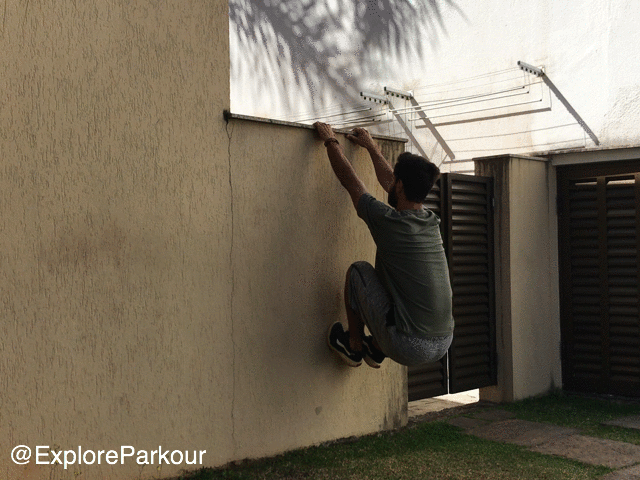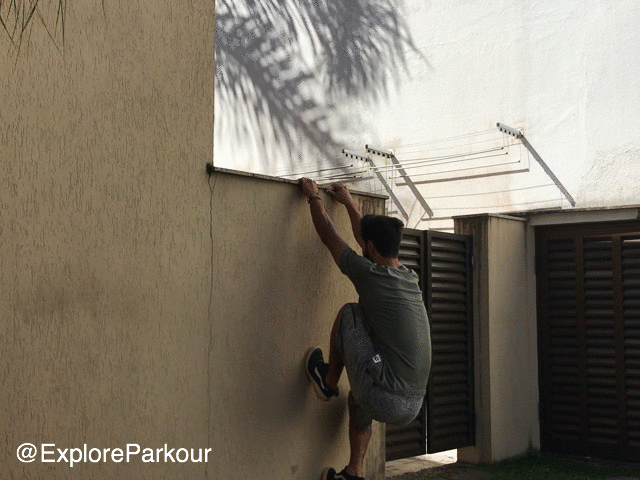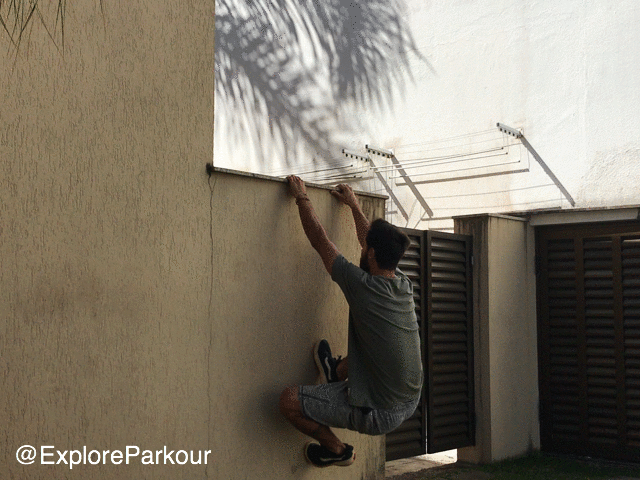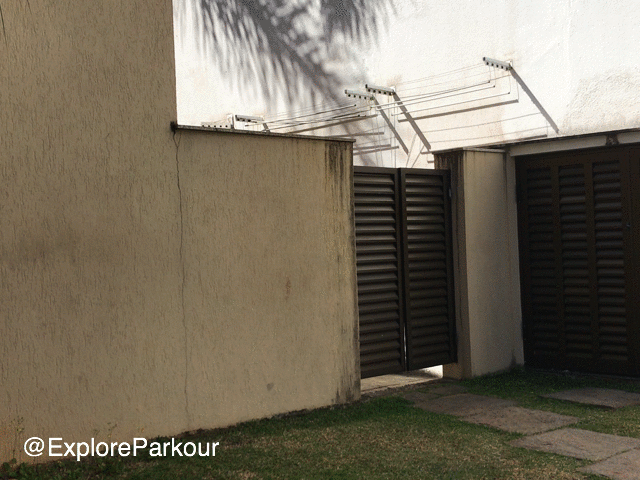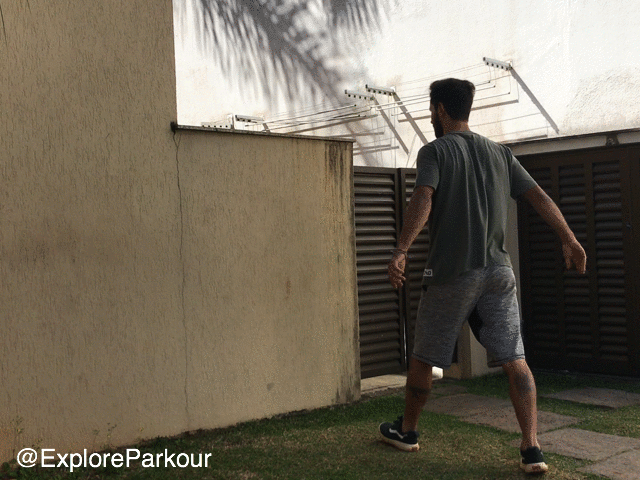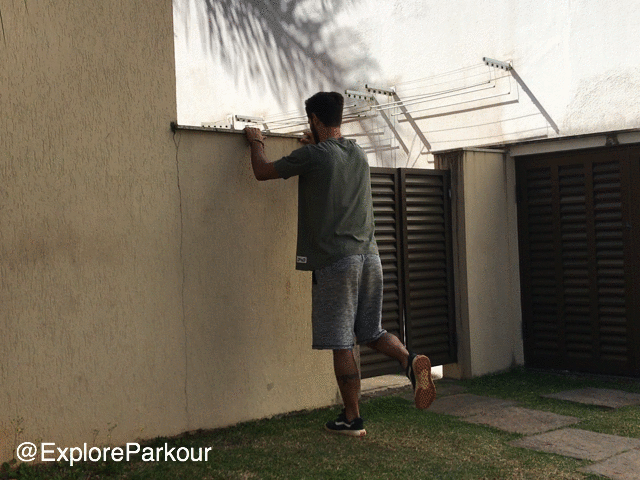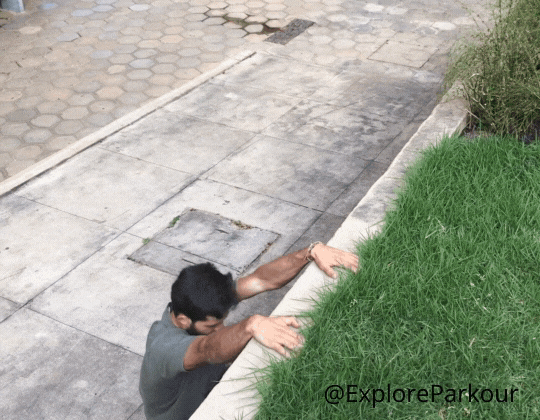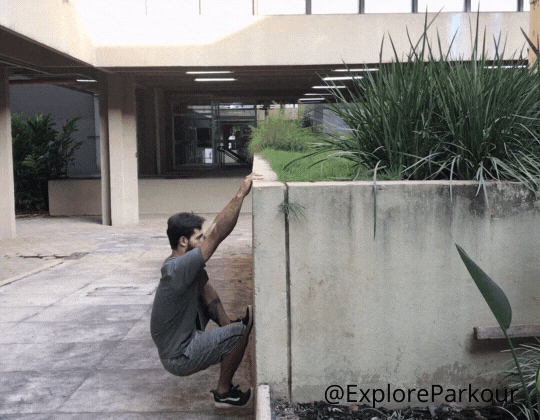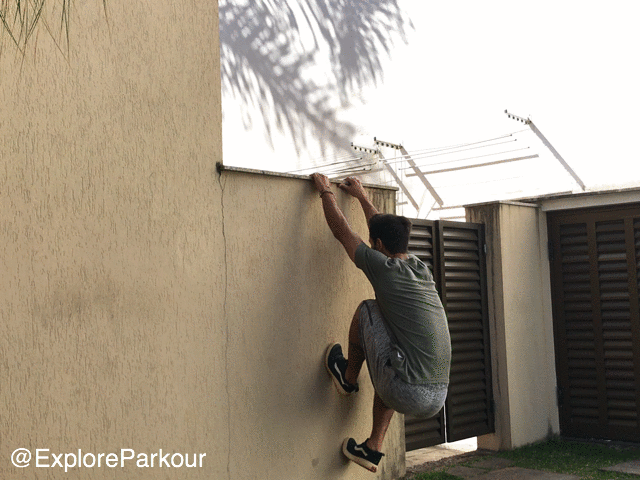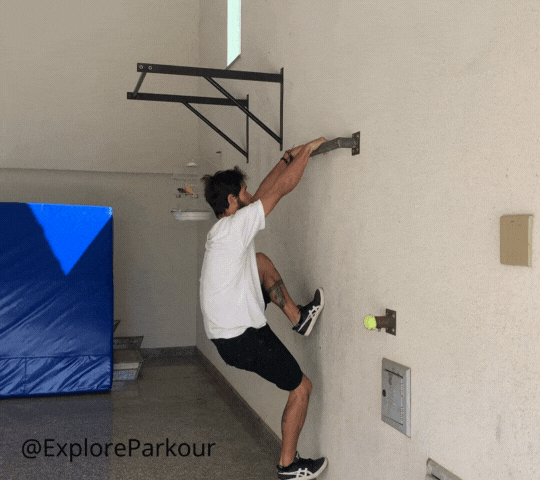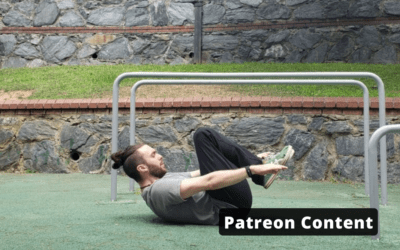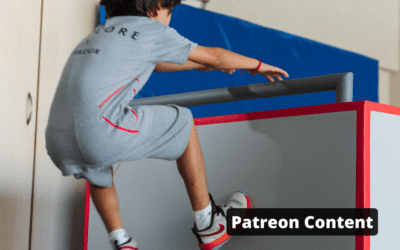Movement Pieces
- Side Shot
- Arms Shot
- Legs Shot
- Back Shot
- Hands Shot
- Other Side Shot
- With Top Out
- Notes on the Sequencing for Climb Up

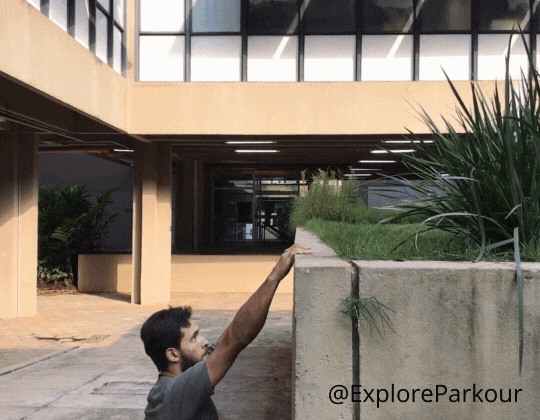

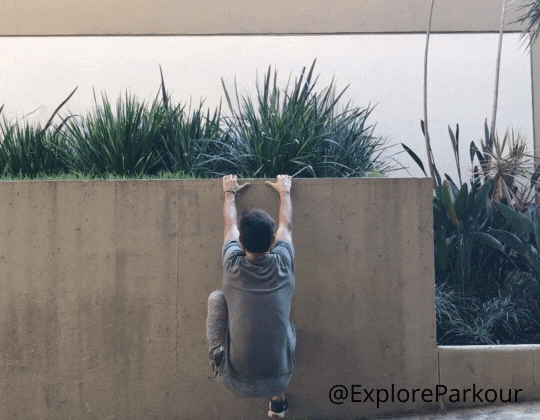




The basic sequence of micro-transitions in this move is…
– Start from a Cat Hang position on a wall high enough so your legs can be in a comfortable staggered position. The upper foot should be used as a support step for when you’re pulling, while the other leg stays low enough to give you room to drive your knee up when the time comes.
– From this position perform an explosive pull and let your support foot push down and into the wall at the same time. when you pull think about bringing your upper body up and forward towards the top of the wall.
– Once your head is above the wall, drive the knee of your lower leg up as explosive as you can, together with your last moments of arms pulling and support foot pushing. This will help you to get enough height to perform the transition from pull to push. Be aware of how much you are pushing with the support foot so that it doesn’t slide down much from the wall.
– Straighten your arms/flick elbows up to the sky, lean your chest toward the wall and place the palm of your hands on the top of the wall as fast as you can while you still feel your body rising from the last movements.
– Finish your climb up in a front support position with hips, torso and shoulder blades engaged.
In case you want to top out…
– Keep one foot against the wall with the bottom of your toes and drive the other leg back/up, bringing your hips up and leaning your chest down (like a kick up).
– Once you have enough room to tuck your legs in, push your chest up with your arms straight and bring your feet to the top of the wall – Just like a Monkey Crawl/Catpass Up Landing.
Common Problems – Start
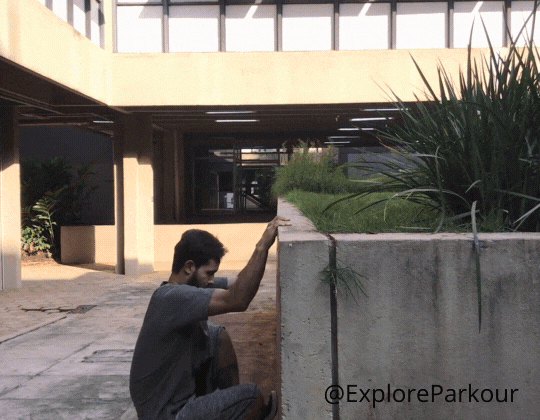
Starting with your arms bent won’t let you use your full pulling ROM. Because of that, you won’t be able to accelerate up or use your knee drive as much as you could. Straight arms can be more difficult at first but it will increase our time for acceleration and allows us to use our legs more with the climb up.

If you don’t transition into a stagger after a cat leap or not paying attention to your legs this can happen. Wall mountain climbers might help you in both cases. It’s not a ideal foot placement because technique wise you can’t easily have both feet at the same height and still have them fulfill each of their individual tasks (one pushes and the other knee drives) as well as they do when they’re staggered.

This could be an environmental issue like the grip or the angle from the top of the wall or if your hand/eye coordination isn’t that consistent. It’s optional to have your thumbs up in a closed grip but you should at least have most of your fingers on the top of the wall so you don’t overload your fingers/forearms. This could be a grip strength issue, otherwise think about letting your palm be placed firmly at the top of the wall and see if can get your first knuckles (the biggest ones) pointing up at the sky in your grip for your cat hang.
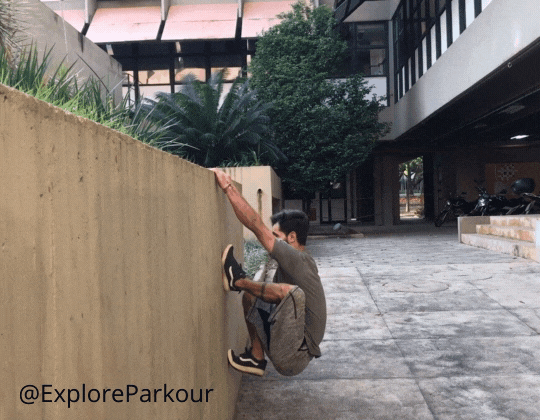
This has a lot to do with your hip and ankle mobility. If you keep your support foot too high you might not be able to use it to climb or even hold the cat hang. Hips and ankles mobility exercises together with wall mountain climbers might help if you need more mobility otherwise spending some time in a staggered cat hang and playing with the wall mountain climbers can help you find a comfortable position.

Again, this has a lot to do with your hip/ankle mobility. In this case, it can come from a lack of awareness of the most effective starting position for this movement as well. With your support foot too low you won’t have it’s help when it comes to pushing into a front support with straight arms. Hips and ankles mobility exercises together with wall mountain climbers might help.
Common Problems – Middle
- Support Leg Pushing Down Wall
- Poor Knee Drive
- Arms Transition too Soon
- Arms Transition too Late
- Rhythm Off
- Arms not Synchronized

Your support foot should push the wall just enough to keep itself there, like a step up. As you go up with your pulling, it is natural to loose grip on this foot but you shouldn’t push so hard that it peels off quickly. This can be a bit dependent on environmental grip but try pushing into the wall more if you find yourself slipping a lot.
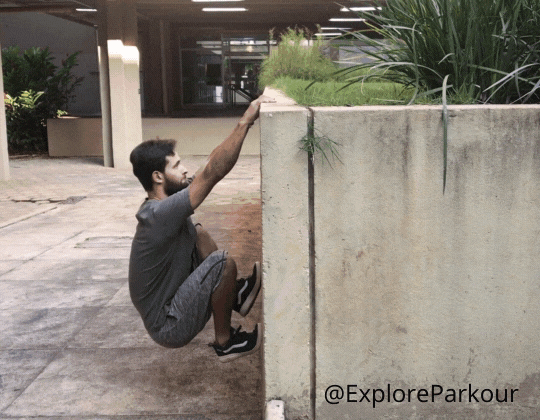
This can be a lack of awareness, pulling too much into the wall (like with a cat hang pull up) or the control of your knee drive. Without a good knee drive you won’t have enough help beside your pulling strength (and pushing foot) to perform your best climb up. Revisit the wall mountain climbers and cat hang pull+knee to understand how to use the knee drive for this movement.

The problem speaks for itself. This could also be happening because you’re leaning your chest too much over the wall or not pulling enough to be able to straighten your arms on the transition. Be sure to get as much as you can out of the pull before you lean forward and transition to the push phase of the climb up.

This won’t make your climb up harder to perform, but it will give you impact on your wrist and shoulder blades, which will also delay your micro transition for a top out or any other coming technique. Pay attention to the rhythm of your momentum so you can catch your weight gently in the support position so you can be ready to move quickly out of it if needed.

In this case, the knee drive is earlier than it should be. It could be the opposite as well. To know the exact right time to perform it together with the pulling and arms transition, read the notes on your left and work on the progressions below. You will know you’re on the right track when the overall effort of the climb up is significantly less than previous attempts.
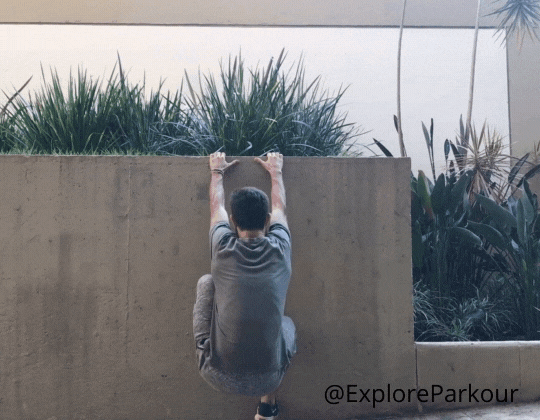
This is usually related to an asymmetric strength on your upper body but could be also due to trying to shift one arm to soon after the knee drive. To perform this technique like this will only create imbalances/impede smooth technique. Try pulling the lagging arm up first and see if that fixes it, otherwise work on balancing your pulling and pushing strength on the weak side with single and both arms pulling/pushing exercises.
Common Problems – End
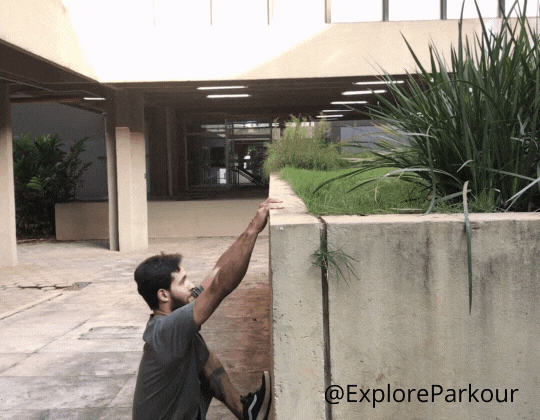
Fix this problem by pulling yourself not just up but forwards as well, don’t forget to bring your hips closer to the wall after the arms transition. Assist progressions and grip strength exercises will help.

When you try too much with your legs to get your pulling height this can happen. Technically and physically this isn’t what you want as you won’t be able to progress from it unless you work on what’s really missing – torso and pulling arm strength and micro-transitions – besides this overload on your back and shoulder blades when you perform it this way. Try thinking about using your arms more/legs less with this movement or address any arms pulling, hollow torso or hip flexor strength deficits that may exist.

This is when your shoulders and scapula aren’t resisting the impact of your weight after your pulling transition; it’s essentially the arms version of bottoming out in a precision jump. Aim your chest down and bring your hips up by engaging your abs with toes against the wall (pecs should feel engaged in your front support to help keep the shoulders pushed down). Work on the front support position, straight arm cats leaps until you’re comfortable and then work on getting yourself straight to that position after your arms transition.

It is very common to see people finishing their climb ups with arms like this. It can be helpful as your shoulder blades will come out when you rotate your arms internally but it can be an issue if you’re relying on this position too much as it can lead to some shoulder imbalances or posture issues that can be exacerbated if not addressed. Think about finishing in a position that allows you to top out or vault smoothly, with your fingers forward. Sometimes you may need to do an easier progression to fix this habit.
Related Exercises
Pull Up
Where should I feel this Exercise? Lats, forearms, triceps, shoulders, and upper back are the movers here. What’s the Main Purpose? Well if you want to climb eventually you’ll have to pull up. This is one of the starting movements required for many ascending and...
Tuck Up
Where should I feel this Exercise? Abs and hip flexors predominantly. Can also use the shoulders and pecs a bit for the arm movement. What’s the Main Purpose? Helps develop power for jumps, flips and other movements (like the cat pass) that require an explosive...
Push Up
Where should I feel this Exercise? Pecs, shoulders, triceps, scapulas, abs, and potentially glutes. What’s the Main Purpose? The push up is one of the first pushing exercises people will start with to build up their upper body pushing strength. For parkour this...
Related Techniques
Cat Leap
Also known as: Cat, Arm Jump, Cat JumpMovement Pieces The basic sequence of micro-transitions in this move is… - Like a Precision Jump, start with your toes at the edge of the obstacle. Squat - close to 1/3 - and bring your arms down and back as you lean forward -...
Dyno
Movement PiecesThe basic sequence of micro-transitions in this move is… - Start from a Cat Hang position on a wall high enough so your legs can be in a comfortable staggered position. The upper foot will be at least waist height and is used to support and push you...
Cat Pass
Also known as: Kong, Monkey Vault or Saut de Chat.Movement PiecesThe basic sequence of micro-transitions in this move is… - Choose a stable obstacle close to your hip height, with short width and enough space to place your hands on the top. - Give yourself enough...

